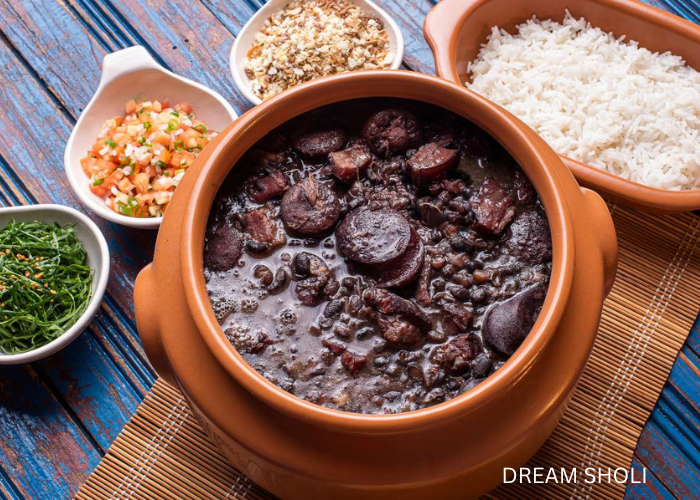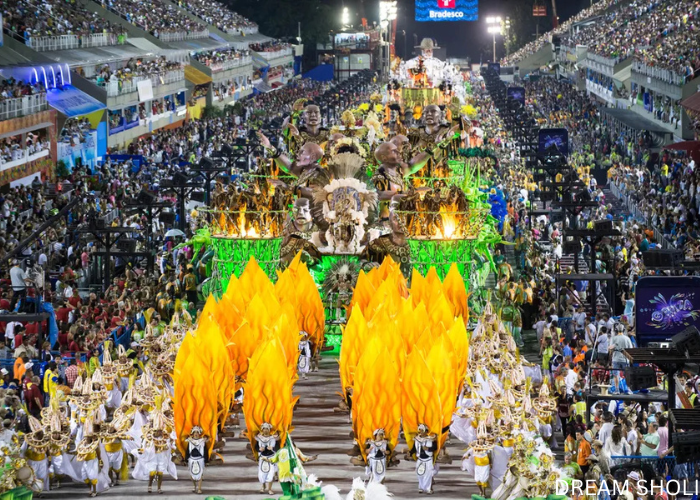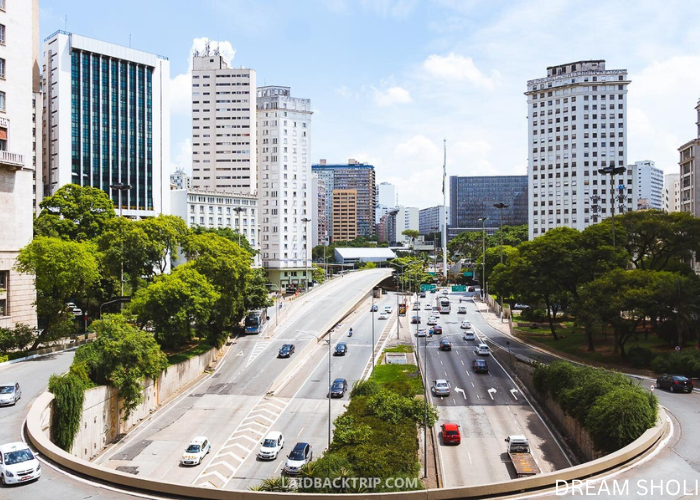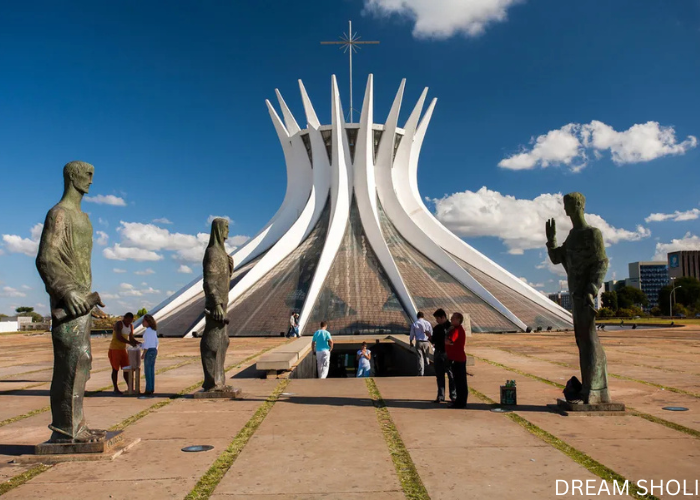
Officially the Federative Republic of Brazil, is a vibrant and diverse country situated in South America. As the largest nation in both South America and Latin America, Brazil shares borders with nearly every other country on the continent, with the exception of Chile and Ecuador. Brazil’s culture is a rich mosaic, reflecting a dynamic blend of Indigenous, African, European, and Asian influences. This fusion is evident in its customs, music, and cuisine, which together create a uniquely Brazilian identity. Among the country’s natural wonders are the expansive Amazon Rainforest, teeming with biodiversity; the Pantanal, one of the world’s largest tropical wetlands; and the awe-inspiring Iguazu Falls. Brazil’s coastline is dotted with famous beaches, including the iconic Ipanema and Copacabana in Rio de Janeiro, which attract visitors from around the world. Brazil’s cuisine is as diverse as its cultural heritage, with dishes that reflect its varied influences. One of its most celebrated dishes is feijoada, a hearty stew made with pork and black beans, often accompanied by rice, collard greens, and orange slices. Street food like coxinhas (fried dough stuffed with shredded chicken) and pão de queijo (cheese bread) is also popular across the country. Brazil’s passion for soccer is unparalleled, with legendary players such as Pelé and Ronaldo emerging from its ranks and a fan culture that is fervent and deeply rooted. The country’s love for music and dance is showcased in its iconic samba rhythms and colorful Carnival celebrations, where people gather in the streets to enjoy vibrant parades and performances. Traveling through Brazil offers a wealth of experiences across its varied landscapes and climates. Whether trekking through dense jungles, enjoying the pristine waters along the coast, or reveling in the exuberance of Carnival, visitors will find adventure and excitement at every turn. To truly appreciate Brazil’s cultural heritage, one can explore its music, dance, and artistic traditions, which reveal the heart of Brazilian society. Historic sites like the Christ the Redeemer statue in Rio de Janeiro, one of the New Seven Wonders of the World, and the colonial town of Ouro Preto, with its preserved baroque architecture, offer insights into Brazil’s history and architectural grandeur. Brazil’s combination of natural beauty, rich traditions, and warm, welcoming people makes it a captivating destination for travelers seeking both adventure and cultural immersion.
Its immense size and varied geography, experiences a range of climates across the country. The majority of the country falls under a tropical climate, characterized by high humidity and consistently warm temperatures throughout the year. The Amazon Rainforest region, for instance, remains hot and humid year-round, with frequent rainfall contributing to its lush environment. This region’s climate is consistent, making it ideal for tropical plants and diverse wildlife to thrive.
Coastal cities like Rio de Janeiro and Salvador also experience a tropical climate, where temperatures stay warm year-round. However, these areas are subject to sporadic rainfall, particularly during the wet season. The combination of warm temperatures and occasional rain showers gives the coastal regions a vibrant, tropical atmosphere, ideal for beach-goers and outdoor enthusiasts. The coastal areas also boast lush landscapes, thanks to the regular rainfall. In contrast, the southern regions of Brazil, including cities like São Paulo and Curitiba, experience a subtropical climate. These areas have more defined seasons, with cooler winters and mild temperatures. The temperature variations are more noticeable in these parts, making them more comfortable during the cooler months. When planning a trip to Brazil, it’s important to consider the specific climate of the region you plan to visit, as weather conditions can differ significantly from the tropical north to the subtropical south.

Brazilian cuisine is a vibrant reflection of the country’s diverse cultural heritage, offering a rich array of flavors and ingredients. The national dish, Feijoada, is a hearty stew made from black beans and a variety of meats, often including pork and beef. It is typically served with rice, farofa (toasted cassava flour), and orange slices. Another popular food is Coxinha, a savory snack that consists of crispy dough filled with seasoned, shredded chicken. Brazil’s tropical climate also influences its food, providing an abundance of exotic fruits such as mango, açaí, and coconut, which are often used in smoothies or desserts. The coastal cuisine is especially famous for Moqueca, a flavorful fish stew made with coconut milk, palm oil, tomatoes, and spices that capture the essence of Brazil’s rich maritime tradition. A favorite dessert, Brigadeiro, made from condensed milk and cocoa powder, is a sweet indulgence served at most celebrations. Brazil’s culture is an intricate blend of indigenous, African, European, and Asian influences, each contributing to its dynamic and colorful society. This multicultural heritage is evident in every aspect of life, from food and festivals to music and dance. The rhythmic beats of samba and the melodic sounds of bossa nova are quintessential to Brazil’s musical identity, and both dance forms are loved worldwide for their lively and infectious energy. Brazil is also home to forró, a folk dance that originated in the Northeast, offering a glimpse into the region’s unique cultural expressions. Portuguese, as the official language, ties the country together while adding a distinct touch to the local dialects, further shaping its cultural atmosphere. The country’s rich cultural landscape extends beyond music and dance into the realm of art and literature. Brazilian art has a storied history, reflecting the diverse traditions and experiences of its people. Many Brazilian artists and writers, such as Clarice Lispector and Oscar Niemeyer, have gained international recognition for their innovative works that bridge the gap between the country’s indigenous roots and contemporary influences. Religion also plays an essential role in Brazil’s cultural fabric, with a blend of Catholicism, Afro-Brazilian faiths like Candomblé, and indigenous spiritual practices shaping many of the nation’s traditions, festivals, and ceremonies. These cultural facets combine to form a country where every corner offers a new opportunity for discovery, making Brazil an exciting destination for anyone seeking a deep, immersive cultural experience.


São Paulo, one of Brazil’s largest and most populous cities, is renowned for its robust economy, cultural diversity, and vibrant atmosphere. As a key financial powerhouse, São Paulo hosts a wide array of communities and cultures. The city boasts numerous attractions, including cultural landmarks like the São Paulo Museum of Art (MASP), the renowned Municipal Market, and the expansive Ibirapuera Park. Known for its dynamic food and nightlife scenes, São Paulo offers a lively mix of culinary experiences and entertainment options. Whether exploring its industrial heart or enjoying its blossoming cultural landscape, São Paulo presents a wealth of experiences for residents and visitors alike.
São Paulo is served by two major airports: Congonhas Airport (CGH), officially São Paulo/Congonhas Airport, which is located closer to the city center and primarily caters to domestic flights within Brazil. It’s a convenient option for those flying within the country. The main international gateway to São Paulo is Guarulhos International Airport (GRU), also known as Governador André Franco Montoro International Airport. As one of the busiest airports in Latin America, GRU handles a high volume of both international and domestic traffic, serving as a key hub for travelers to and from the region.


A vibrant city renowned for its colorful colonial architecture, dynamic music scene, and rich Afro-Brazilian heritage. The heart of the city, Pelourinho, is a UNESCO World Heritage Site filled with pastel-hued buildings, cobblestone streets, and lively squares where locals and visitors gather to enjoy music and dance. This historic district offers an authentic glimpse into the cultural fabric of Salvador, where the past and present harmoniously coexist.
The city is also famous for hosting one of Brazil’s largest and most spirited festivals, which features extravagant costumes, infectious rhythms, and lively street parades. Salvador’s cuisine is a tantalizing fusion of indigenous, Portuguese, and African influences, offering a delightful culinary journey for those who visit. With its picturesque beaches, rich cultural traditions, and warm, welcoming people, Salvador is a true representation of the vibrant spirit of Brazil. Salvador’s main gateway is the Deputado Luís Eduardo Magalhães International Airport (SSA), which connects the city to both domestic and international destinations. This airport serves as the primary point of entry for those exploring Salvador’s stunning beaches, historic landmarks, and lively cultural scene. With its modern facilities and strategic location, the airport plays a vital role in bringing travelers from around the world to experience the beauty and energy of this captivating city.
Brazil’s capital city, Brasília, is renowned for its modernist urban planning and distinctive architecture. Designed by architects Lúcio Costa and Oscar Niemeyer in the 1950s, the city’s layout, visible from above, is often compared to the shape of an airplane or bird. The city holds immense political significance, marked by key landmarks such as the Three Powers Plaza, which houses the Presidential Palace, National Congress, and Supreme Federal Court. In 1987, Brasília’s architectural and urban planning significance earned it a UNESCO World Heritage Site designation. The city’s diverse economy, efficient transit system, and status as the political heart of Brazil make it an intriguing destination. Additionally, Brasília boasts a rich cultural scene, with a variety of arts events, including theater, dance performances, and music festivals, reflecting the city’s vibrant artistic expressions and enhancing its unique identity.
The primary airport serving Brasília is Presidente Juscelino Kubitschek International Airport (BSB), named after Brazil’s former president who played a crucial role in the city’s creation. As the third busiest airport in the country, BSB connects the capital to both domestic and international destinations. The airport offers a range of services and amenities to passengers, playing a key role in facilitating travel to and from Brasília.


Explore the world effortlessly with our tailored travel packages. Let us handle the details while you create unforgettable memories.
Copyright 2024 Dream Sholi